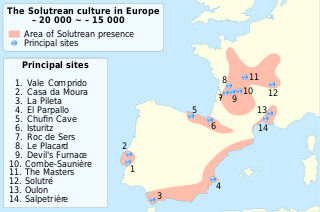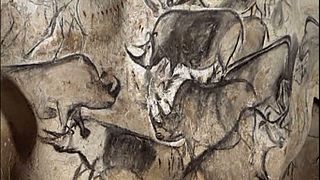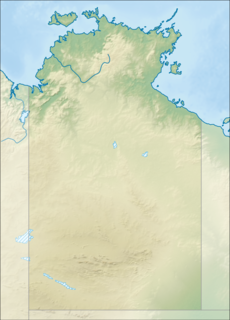Related Research Articles

The Paleolithic or Palaeolithic or Palæolithic, also called the Old Stone Age, is a period in human prehistory distinguished by the original development of stone tools that covers c. 99% of the period of human technological prehistory. It extends from the earliest known use of stone tools by hominins c. 3.3 million years ago, to the end of the Pleistocene c. 11,650 cal BP.

Cave paintings are a type of parietal art, found on the wall or ceilings of caves. The term usually implies prehistoric origin, and the oldest known are more than 44,000 years old, found in both the Franco-Cantabrian region in western Europe, and in the caves in the district of Maros. The oldest are often constructed from hand stencils and simple geometric shapes. However, more recently, in 2021, cave art of a pig found in an Indonesian island, and dated to over 45,500 years, has been reported.

The Solutrean industry is a relatively advanced flint tool-making style of the Upper Paleolithic of the Final Gravettian, from around 22,000 to 17,000 BP. Solutrean sites have been found in modern-day France, Spain and Portugal.

The Gravettian was an archaeological industry of the European Upper Paleolithic that succeeded the Aurignacian circa 33,000 years BP. It is archaeologically the last European culture many consider unified, and had mostly disappeared by c. 22,000 BP, close to the Last Glacial Maximum, although some elements lasted until c. 17,000 BP. At this point, it was replaced abruptly by the Solutrean in France and Spain, and developed into or continued as the Epigravettian in Italy, the Balkans, Ukraine and Russia.

The Upper Paleolithic also called the Late Stone Age is the third and last subdivision of the Paleolithic or Old Stone Age. Very broadly, it dates to between 50,000 and 12,000 years ago, according to some theories coinciding with the appearance of behavioral modernity in early modern humans, until the advent of the Neolithic Revolution and agriculture.
Prehistoric music is a term in the history of music for all music produced in preliterate cultures (prehistory), beginning somewhere in very late geological history. Prehistoric music is followed by ancient music in different parts of the world, but still exists in isolated areas. However, it is more common to refer to the "prehistoric" music which still survives as folk, indigenous or traditional music. Prehistoric music is studied alongside other periods within music archaeology.

Aboriginal Australians are the various Indigenous peoples of the Australian mainland and many of its islands, such as Tasmania, Fraser Island, Hinchinbrook Island, the Tiwi Islands, and Groote Eylandt, but excluding the Torres Strait Islands. The term Indigenous Australians refers to Aboriginal Australians and Torres Strait Islanders collectively. It is generally used when both groups are included in the topic being addressed. Torres Strait Islanders are ethnically and culturally distinct, despite extensive cultural exchange with some of the Aboriginal groups. The Torres Strait Islands are mostly part of Queensland but have a separate governmental status.

Lagar Velho is a rock-shelter in the Lapedo valley, a limestone canyon 13 km from the centre of Leiria, in the municipality of Leiria, in central Portugal. The site is known for the discovery of a 24,000-year-old Cro-Magnon child, later referred to as the Lapedo child.
Australian archaeology is a large sub-field in the discipline of archaeology. Archaeology in Australia takes three main forms: Aboriginal archaeology, historical archaeology, and maritime archaeology. Bridging these sub-disciplines is the important concept of cultural heritage management, which encompasses Aboriginal and Torres Strait Islander sites, historical sites, and maritime sites.

Australian Aboriginal artefacts include a variety of cultural artefacts used by Aboriginal Australians. Most Aboriginal artefacts were multi-purpose and could be used for a variety of different occupations. Spears, clubs, boomerangs and shields were used generally as weapons for hunting and in warfare. Watercraft technology artefacts in the form of dugout and bark canoes were used for transport and for fishing. Stone artefacts include cutting tools and grinding stones to hunt and make food. Coolamons and carriers such as dillybags, allowed Aboriginal peoples to carry water, food and cradle babies. Message sticks were used for communication, and ornamental artefacts for decorative and ceremonial purposes. Aboriginal children’s toys were used to both entertain and educate.

The Late Stone Age (LSA) is a period in African prehistory that follows the Middle Stone Age.

The art of the Upper Paleolithic represents the oldest form of prehistoric art. Figurative art is present in Europe and Southeast Asia, beginning between about 40,000 to 35,000 years ago. Non-figurative cave paintings, consisting of hand stencils and simple geometric shapes, are somewhat older, at least 40,000 years old, and possibly as old as 64,000 years. This latter estimate is due to a controversial 2018 study based on uranium-thorium dating, which would imply Neanderthal authorship and qualify as art of the Middle Paleolithic.

Early European modern humans (EEMH) or Cro-Magnons were the first early modern humans to settle in Europe, continuously occupying the continent possibly from as early as 48,000 years ago. They interacted and interbred with the indigenous Neanderthals, who went extinct 40 to 35 thousand years ago; and from 37,000 years ago onwards, all EEMH descended from a single founder population which contributes ancestry to present-day Europeans. EEMH produced Upper Palaeolithic cultures, the first major one being the Aurignacian, which was succeeded by the Gravettian by 30,000 years ago. The Gravettian split into the Epi-Gravettian in the east and Solutrean in the west, due to major climate degradation during the Last Glacial Maximum (LGM), peaking 21,000 years ago. As Europe warmed, the Solutrean evolved into the Magdalenian by 20,000 years ago, and these peoples recolonised Europe. The Magdalenian and Epi-Gravettian gave way to Mesolithic cultures as big game animals were dying out and the Last Glacial Period drew to a close.

The University of Queensland Anthropology Museum is in Brisbane, Australia. It houses the largest university collection of ethnographic material culture in Australia.

The El Mirón Cave is a large cave in the upper Asón River valley towards the eastern end of Cantabria in northern Spain, near the border of the Basque Country. It is an archeological site in Ramales de la Victoria. It is known for a skeleton belonging to a woman nicknamed The Red Lady of El Mirón. She is estimated to have died around 18,700 years ago, during the Upper Paleolithic (Magdalenian). The skeleton is examined to that of someone between 35 and 40 years. Her bones were coated with ochre, a red iron-based pigment, hence, her name.

Madjedbebe is a sandstone rock shelter in Arnhem Land, in the Northern Territory of Australia, said to be the site of the oldest evidence of human habitation in the country. It is located about 50 kilometres (31 mi) from the coast. It is part of the lands traditionally inhabited by the Mirarr, an Aboriginal people of the Gunwinyguan linguistic group. Although it is surrounded by the World Heritage Listed Kakadu National Park, Madjedbebe itself is located within the Jabiluka Mineral Leasehold.
Laila Haglund is an archaeologist who played a key role in establishing consulting archaeology in Australia, and in drafting Queensland's first legislation to protect Aboriginal cultural heritage.
Caroline Bird is an Australian archaeologist and educator. She specialises in women's studies, cultural heritage, and indigenous studies in the archaeological context, specifically early Australian archaeology. Bird's other focuses include lithic technology and art.

The Cave of Pego do Diabo is a small karst cave in a Turonian limestone outcrop located about 250 metres above sea level in the municipality of Loures, about 20 km north of Lisbon in Portugal. The erosion of the outcrop resulted in a set of openings in the rocks wide enough to be exploited by humans. Several archaeological studies have been conducted within the cave, which give insights into the duration of Neanderthal presence on the Iberian Peninsula and to the presence of carnivorous animals during the Paleolithic.
References
- 1 2 "Dr Tiina Manne". University of Queensland. Retrieved 1 May 2021.
- ↑ "Thousands of Ancient Aboriginal Sites Probably Damaged in Australian Fires". Scientific American. 27 January 2020. Retrieved 1 May 2021.
- ↑ "NATIONAL EXECUTIVE COMMITTEE: Meet the Team". Australian Archaeological Association. Retrieved 1 May 2021.
- ↑ "25 March ballot results". Society of Antiquaries of London. 25 March 2021. Retrieved 30 April 2021.